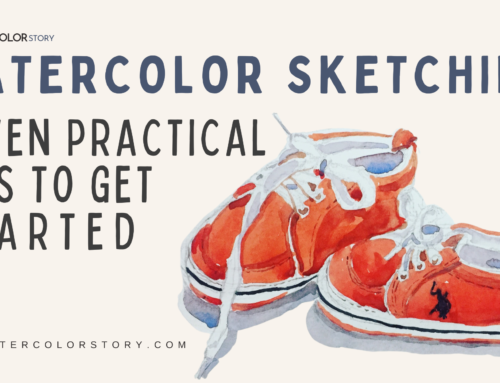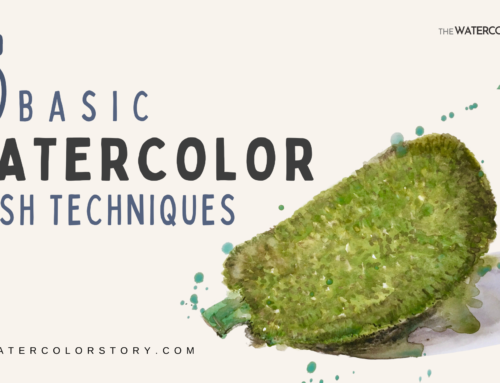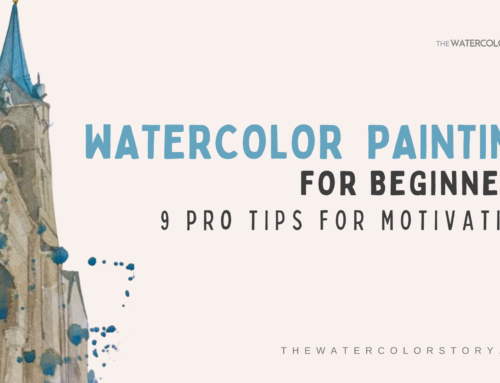
Painting on a watercolor sketchbook can be one of the most interesting ways of practicing the Watercolor media as a whole.
For many people painting in watercolors, this is probably the only form they do & never touch a paper size bigger than the sketchbook.
This is true for me to a certain extent too.
The joy of illustrating/painting on a Watercolor Sketchbook can be tremendous once you get the taste of it.
But yes I get it. You are not here to discuss that.
Rather you want to know some useful tips on how to paint in watercolors on a Sketchbook. Right?
I have around 7 years of experience as on date of writing this article on Watercolor Sketchbooks. Therefore I will share with you all the practical tips on how you too can start painting/illustrating with Watercolors on a Sketchbook.
You don’t need to be a hardcore Watercolorist to excel in this.
Before we start out on the tips, let me answer one question in a few words, that is on your mind.
“How do you paint with Watercolors in a Sketchbook?”
Painting with watercolors in a Sketchbook is a pretty simple & minimal affair. There are certain sketchbooks in market with papers suited for watercolors(or you can simply make one with the papers you like) in which you paint loosely with just one brush(preferably) & a very limited choice of colors(called palette). The subjects are simple, otherwise unnoticed things that you see everyday, but not necessarily notice & admire. Most artists use a pencil or a waterproof ink pen for the under-drawing but there is no hard & fast rule to that. People paint with watercolors in sketchbooks for various reasons, but this itself has become a sub-genre under Watercolor painting & there is a global community of like minded artists who does it on a daily level.
So let’s get started with the tips that will not only help you start painting on your first Watercolor Sketchbook, but will also prepare you for the awesome days to come.
NEVER WORRY ABOUT SEARCHING FOR THE RIGHT WATERCOLOR SKETCHBOOK ON DAY ONE ITSELF
This is perhaps a very unexpected or unshared tip that you will read here. But I have seen so many artists struggling with choosing the right Sketchbook for them.
I mean Yes, that is fair enough. Fair enough that you are searching for the best Sketch book.
But that should definitely not be at the cost of you not painting or illustrating on the ones that you already have.
From my experience, I have learnt that settling on the right kind of paper is a gradual process. You simply cannot finalise one kind of paper that you will forever use from this day onwards. A little bit of disappointments with papers is always something that you will face as a Watercolor artist.
So my point here is that as I mentioned before, painting on a Watercolor Sketchbook is a minimal affair. So why complicate it with choosing the right sketchbook first?
Just start painting on the one that you already have or can afford.
The more important idea here is to get started. Do not worry about the end result being a disappointment at this stage. Trust me. You will do good as you flip the pages forward.

Image Credit: Namchai Saensupha
USE MINIMAL TOOLS & COLOR PALETTE
Again I will stress on the word “minimal” here.
You will not need a huge number of colors to create something beautiful. If you have a good sense of the color theory, even the primary colors will derive so many colors out of them.
But how will you have a good sense of the color theory?
Of course by practicing them with your own hands & not by just watching a Youtube video(I made this mistake, hence the example).
Since the pages of a Watercolor Sketchbook is usually small, the lesser the colors the better & fresher your painting will look.
Even if you are a beginner, you should start with minimal color palettes. You will not find a better way to practice the color theory?
USE A DRAWING PENCIL OR A WATERPROOF PEN FOR THE BASE DRAWING
Since the usual size of a Watercolor Sketchbook is small, it is ideal to use a pencil or a pen with waterproof ink for the base drawing.
I personally love fountain pens for this, but have also achieved wonders with a simple pencil.
These pencils or pens supported by watercolor brush strokes define the shape of the objects beautifully.
Very often I see artists doing all the drawing/sketching with a pen or a pencil for depicting tonal values & use a very low quantity of Watercolor at the end. But these works are in no way inferior. Infact I have seen superior quality works in this style.
DO NOT GO INTO TOO MUCH DETAILS. JUST CAPTURE THE ESSENCE
The primary idea of sketchbooks is to quickly capture the essence of a subject. You may use that as a reference later for a detailed painting too.
But as of now, just limit your strokes, layers & quantity of colors in a Sketchbook painting. You must create the essence of the subject with suggestive strokes that will fool the eye into believing it to be a three dimensional thing/scene.
This has so much to do with practice & skill. Both work together for each other.
The only thing that should be consciously on your mind is that how do I capture the most minimal details in the subject that I am painting & yet not miss out anything important.
Half your battle with the Watercolor medium is already won here.

Image Credit: Namchai Saensupha
BE QUICK WITH YOUR WORK
In order to capture only the essence of the subject, you should be very quick with your work.
That can sometimes create mistakes too. But who cares?
Your sketchbook is your closest friend & some secrets can be kept there forever.
You should be very quick with your drawing as well as the painting process.
I asked a few of my fellow artists how much time they usually take to finish a painting on a Watercolor Sketchbook & after averaging the data, I found out that the number is 18minutes. I think yes that is a reasonable time to finish a Watercolor painting in a Sketchbook.
I personally take a bit more time on that & it reaches to 25-30 minutes. But I am working on that. The faster I paint, the fresher it will look.
KEEP IN MIND ONLY LIGHT & SHADE. REST WILL FOLLOW
Previously I mentioned something about “capturing the essence” of the subject as something that should be consciously on your mind while painting in a Watercolor Sketchbook.
Let me tell you that this is nothing but the concept of light & shade. If you are not comfortable right now with this concept, then just think one thing in mind while painting: Where is the light coming from & how shadow is being created in the opposite side of it.
You just need to mimic that.
Rest will definitely follow.
TAKE NOTES ON YOUR SKETCHES
An ideal & a very interesting tip to make your watercolor sketchbook pages look even more beautiful, engaging, motivating & beautiful is to take notes in the paintings itself.
Do not forget that your Watercolor Sketchbook is a tool for you to learn the qualities one must possess as an artist. These small paintings in your sketchbook are references & timeline of your practice.
So when you take notes, you essentially write something for yourself that you might have learnt in that moment. Trust me again, this will be of so much help in the days to come.
Sometimes you also enhance the visual memory of a scene or an object with words. The whole idea seems so poetic to me.
Its motivating too. Isn’t it?
DO NOT STRUGGLE IN CHOOSING YOUR SUBJECT. JUST PAINT WHAT YOU SEE AROUND
Since Watercolor sketchbooks are usually meant to be private in nature, you should therefore never struggle to decide what to paint. The answer to your dilemma should always lie in two simple words: “paint anything”
The smallest of the things around you usually make up great subjects for your Sketchbook pages. You should just notice everyday things around you. These things have so much personality hidden. Once you look at them closer you will admire them even more & your paintings as a whole will elevate to a different level.
So these are some of the tips that I shared with you from what I have personally learnt so far about painting on Watercolor Sketchbooks.
Do share your tips in the comments below & if i find it helpful, I will feature it on this post itself.





[…] PAINTING ON WATERCOLOR SKETCHBOOK: 8 PRACTICAL TIPS […]
[…] Painting on Watercolor Sketchbook: 8 practical tips […]